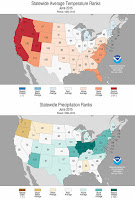The 2014 State of the Climate report makes it plain that last year was a landmark in global warming. The record high in globally averaged temperature (a mark almost certain to be topped in 2015) got plenty of press, but other records were set as well:
- Carbon dioxide, methane, and nitrous oxide—three of the most important human-produced greenhouse gases—all reached their highest global concentrations since records have been kept.
- More than 20 nations reported their warmest year on record, as did the continent of Europe. The only large land area with below-average temperatures for the year (apart from western Siberia) was eastern North America.
- Sea surface temperatures and global sea level both reached record highs, continuing the trends of recent years.
- The extent of summertime Arctic sea ice remained well below its 1980s – 1990s average, though the ice loss in 2014 was less dramatic than in several years of the past decade. Meanwhile, Antarctic sea ice set new monthly extent records in each month from April to November, and the single largest extent on record was observed on September 20. It’s important to note that this wintertime ice growth around Antarctica has much less effect on climate than the summertime loss in the Arctic, largely because the Arctic loss occurs when more sunshine has a chance to be absorbed by open water.
Read more at State of the Climate Report: Warm and Warmer (Except for Eastern North America)

No comments:
Post a Comment